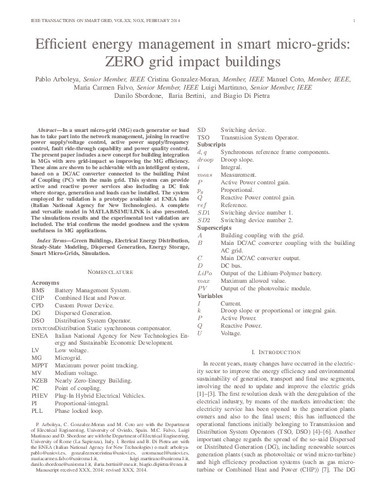Efficient energy management in smart micro-grids: ZERO grid impact buildings
Palabra(s) clave:
Green buildings
Electrical energy distribution
Steady-state modeling
Dispersed generation
Fecha de publicación:
Editorial:
IEEE
Versión del editor:
Citación:
Descripción física:
Resumen:
In a smart micro-grid (MG) each generator or load has to take part in the network management, joining in reactive power supply/voltage control, active power supply/frequency control, fault ride-through capability, and power quality control. This paper includes a new concept for building integration in MGs with zero grid-impact so improving the MG efficiency. These aims are shown to be achievable with an intelligent system, based on a dc/ac converter connected to the building point of coupling with the main grid. This system can provide active and reactive power services also including a dc link where storage, generation, and loads can be installed. The system employed for validation is a prototype available at ENEA Laboratories (Italian National Agency for New Technologies). A complete and versatile model in MATLAB/SIMULINK is also presented. The simulations results and the experimental test validation are included. The trial confirms the model goodness and the system usefulness in MG applications
In a smart micro-grid (MG) each generator or load has to take part in the network management, joining in reactive power supply/voltage control, active power supply/frequency control, fault ride-through capability, and power quality control. This paper includes a new concept for building integration in MGs with zero grid-impact so improving the MG efficiency. These aims are shown to be achievable with an intelligent system, based on a dc/ac converter connected to the building point of coupling with the main grid. This system can provide active and reactive power services also including a dc link where storage, generation, and loads can be installed. The system employed for validation is a prototype available at ENEA Laboratories (Italian National Agency for New Technologies). A complete and versatile model in MATLAB/SIMULINK is also presented. The simulations results and the experimental test validation are included. The trial confirms the model goodness and the system usefulness in MG applications
Colecciones
Ficheros en el ítem




